Unsure how to upgrade from static to digital drive thru menu boards? Need to know where to start?
If you would like to just view a certain part of the eBook click on the section link below:
Drive thru digital signage as used by leading QSR chains. Advertise in any weather thanks to an IP56/65 rating and internal climate controls. Available with a screen and media player included.
The drive thru digital kiosk is the ideal mounting solution for Samsung's OH46F/OH55F displays. Install up to three screens and position the freestanding totem in the most profitable location.
Install digital menu boards in any location with the drive thru digital signage enclosure. The industry-rated enclosure protects a high-bright screen in any climate, for year-round advertising ROI.
The QSR outdoor digital signage totem protects a screen from rain, windblown dust and physical damage. Benefit from secure, robust and reliable digital menu boards outside your QSR.
QSR outdoor digital signage enclosure for 32" to 49" screens. Internal climate controls allow continuous advertising from -30° to 55°C. Available with screen and media player included.
Mount up to three Samsung OH46F/OH55F screens on the QSR multi-screen drive thru totem. Attract customers with sunlight-readable menus and advertise reliably in all weather.
Triple-screen digital drive thru menu board for outdoor locations. The IP56/65 rating protects against rain and windblown dust. Internal climate controls ensure reliable operation from -30°C to 55°C.
Weatherproof digital drive thru menu board enclosure for 32" to 75" screens. The portrait orientation displays menus in a traditional poster format that's engaging and easy-to-read.
Digital menu board company providing weatherproof, high-bright digital signage for restaurants and drive thrus. Engage customers with single, double or triple-screen options.
McDonald's and Starbucks have chosen Armagard's outdoor digital menu boards for their drive thru lanes. Find out how they use them to boost sales, improve service and make menu changeovers easier for staff. Read the full story here.
Digital signage has transformed restaurant operations and management, making menu updates quicker and easier, improving the customer experience and boosting sales. Restaurant digital signage is a highly practical way to display your menu and drive your restaurant's business strategy, with multiple options available to you...
Presell digital drive thru menu boards give quick service restaurants a way to promote specials, limited time offers, new menu items or entertain customers. Presell menu boards reduce perceived waiting times and help to influence customer buying decisions very early on.
A recent YouGov poll indicates that '45 percent of Americans find it difficult to make healthy eating choices'. Part of the problem is a lack of proper nutritional labelling featured on restaurant menus. Here's how Drive Thru Digital Menu Boards can guide fast food patrons toward healthier options...
You dress according to the weather, right? If it's hot, you wear loose fitting clothes. If it rains, you wear a waterproof jacket, maybe. If it snows… well you get the idea. The same principle applies to your digital drive thru menu network, it needs to be 'dressed' accordingly to survive the outdoors...
Illuminated menu boards for the drive thru come in all shapes and sizes, but they each have one purpose… attracting fast food lovers. The more enticing, engaging and easy to read your illuminated menu boards are, the better chance your quick service restaurant has of tempting new customers and retaining the regulars...
Turns out that choosing a UK digital signage manufacturer is hard work. To help you navigate the market, this 5 step guide will help you to spot a reputable digital signage provider for your project.
UK digital signage manufacturer, Armagard has launched its new look digital drive thru menu board range for the UK, Quick Service Restaurant (QSR) scene.
If you're in the fast food restaurant game, you will know that drive thru digital menu boards are trending right now. Nevertheless, you've resisted the urge to spend on a digital menu board network, unconvinced by the hype and thinking that digital signage can't really add value to your drive thru lane. You're wrong...
If your outdoor menu boards are not boosting fast food sales or delivering a worthwhile return on investment (ROI), they're not much use to your QSR chain. To get more from your outdoor menu strategy, here's what we propose...
The cost of digital outdoor menu boards is subjective because there are so many variables to consider. Every drive thru digital signage installation is unique... Therefore, it's not a question of how much it will cost, it's a question of how much you're willing to pay.
Opening a drive thru lane at your quick service restaurant takes a lot of planning, involves a lot of red tape and requires a lot of capital. To make your money back, you need a Eye-Catching drive thru design that will actually entice patrons in order to boost restaurant revenues...
Sell more from your fast food menu using a winning fast food formula that combines digital menu boards at the drive thru and millennials. It may seem like a strange combination, but hear us out. After all, it's proving to be one of the biggest hits for shifting fast food menu items this century...
The use of outdoor digital signage at the drive thru has steadily increased, not only in the USA, but worldwide and the upward trend will continue in 2017. So, what changed?
The mission to boost quick service restaurant (QSR) sales has taken to the drive thru lane, with outdoor LCD and LED menu boards going head-to-head to become the screen technology of choice. As fast food chains look to improve the customer experience at the drive thru, are LCD or LED displays better suited to the task?
Looking for outdoor illuminated drive thru boards for your restaurant's drive thru lane? There's plenty to choose from, right? However, which offer you the best value for money and the flexibility you need to drive sales at your drive thru?
The task of enticing new QSR customers, and retaining loyal ones, has certainly become more challenging in today's 'instant' society. As a result, the fast food menu in the UK has had to evolve. Cue the next evolution of the outdoor menu display.
Outdoor Digital Signage Specialists, Armagard Previews ISE 2017 Ahead of Attending the Event - February 7 - 10.
Did you know? Your restaurant's drive thru lane has the potential to increase sales in fast food by up to 8%....
Learn The Basics Of Switching From Static To Digital Drive Thru Menu Boards
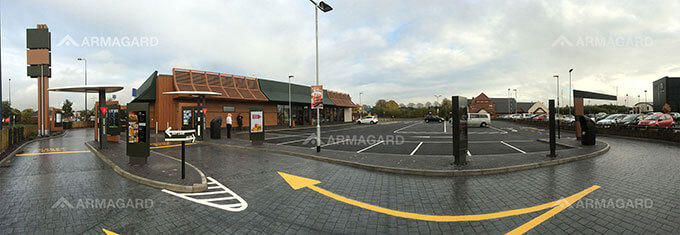
If you would like to just view a certain part of the eBook click on the section link below:
We can sympathise with you if you're a restaurant operator and you're struggling with the switch from static to digital drive thru menu boards. Much like an eatery with a 20-page menu, you're spoilt for choice with the options available, and choosing a solution to fit your needs can seem like a colossal task.
Equally, it's likely you don't even know what you need, which means you don't know what questions to ask and you can quickly find yourself sinking under a sea of screens, media players, and software tools etc...
To avoid being bamboozled, this 'what you need to know' guide arms you with the basics for transitioning from static to outdoor digital menus, meaning you're not making a buying decision, blind. Let's get you started.
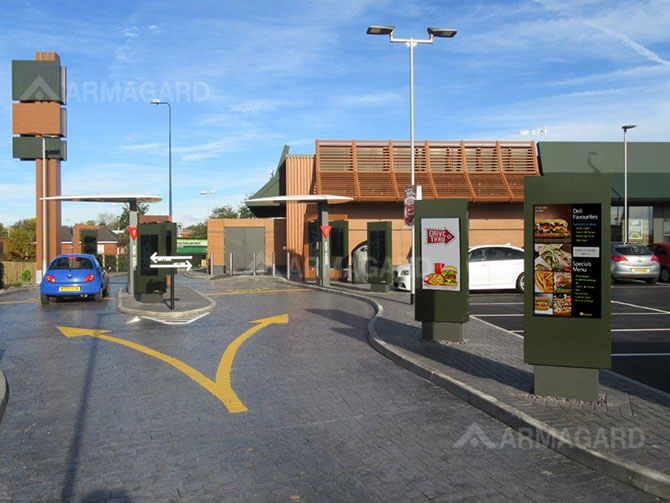
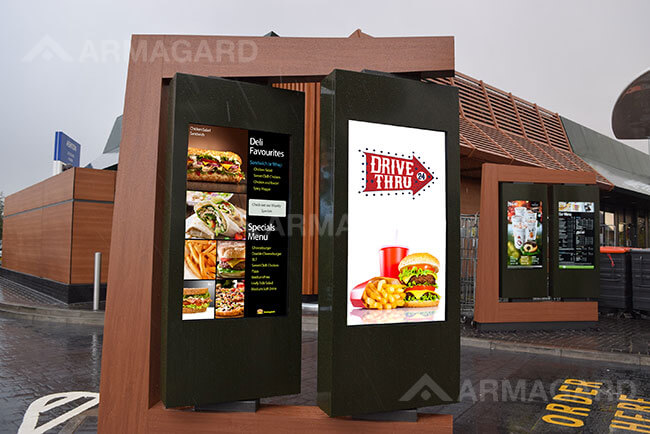
Choosing the right display is arguably the most difficult decision to make. Why? There's so darn many! There's LCD, LED and even Plasma screens. Not only do you need an outdoor TV that looks 'easy on the eye', but it has to be compatible with whatever software you choose and it needs to be robust - capable of repelling the weather, vandals and thieves.
You're probably thinking, 'I'll play it safe with a brand name.' A word of warning, brand names aren't always best. Please… don't base your buying decision on brand alone, as some lack the necessary features needed to survive as a digital menu board. For instance, many can't be used in direct sunlight.
You can rule out plasma screens immediately. Why? Plasma screens are known to suffer from what's known in the industry as 'screen burn.' What's screen burn? It's a phenomenon that occurs when a static image is displayed for extended periods of time, like on a digital drive thru menu board, which ends up leaving a residual impression that can't be rectified.
That leaves you with a choice between LCD or LED screens. What's the difference? There's a fundamental difference when it comes to the screen type used for drive thru menus. LCD screens commonly use cathode fluorescent light (CFL) bulbs, but advances in technology have seen the emergence of LCD screens using LED backlighting.
These screens deliver higher resolution images that are crisp and clear when viewed from a short distance (which suits the drive thru lane). In contrast, LED screens use light emitting diode (LED) bulbs and are more commonly used for roadside signage as they can be viewed from a distance.
Some drive thru facilities do use them as digital menu boards. However, displaying high quality images of menu items using LED screens can be problematic.
How does that affect your decision? Well, it comes down to cost versus efficiency. In LED screens you're purchasing a solution that uses less power, emits less heat and are lighter and slimmer than their LCD counterparts. However, all those features come at a cost when compared with LCD TVs. The reality is, LCD screens can be sourced at a lower price.
Equally, LED screens lack the ability to display crisp, clear images of menu items in order to make food items look more appetising. They're difficult to view up close too, which is an issue when using them at the drive thru.
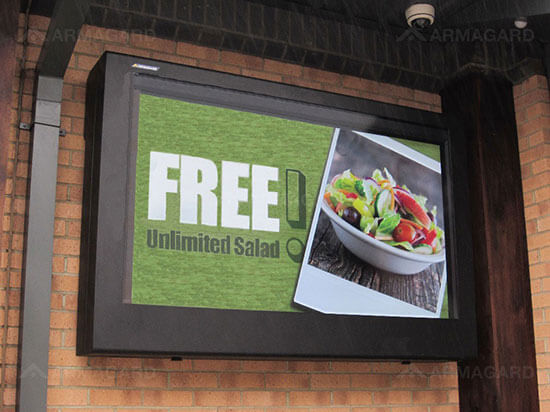
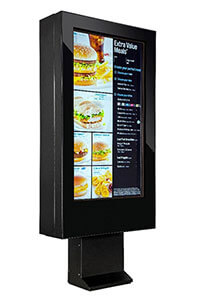
Understanding screen resolution will equip you with the necessary knowledge for choosing a screen to use as a digital drive thru menu.
Screen resolution often causes confusion. Are you familiar with 720p and 1080p? You probably recognise them, as they're used to indicate the screen resolution of TV displays and are classed as 'high definition' (HD) video formats. However, it's not strictly correct to label them HD formats as they're actually meant to inform you of a screen's capability to playback a type of broadcast content.
A screen's resolution is actually measured in pixels:
[The information above is dependent on whether digital drive thru menu boards are installed in portrait or landscape orientation].
What's all this got to do with drive thru digital menu boards? Well, if you were to use a 720p screen to display menu content, you would be limited in the amount of content you could show. By using screens with a higher resolution for your outdoor digital signage network, you can display more content.
1080p screens probably lead the way in the market, with value for money and the ability to display more content, being two of the key factors that make these screens the most attractive choice. This is because 4K screens are still priced at a premium. Plus, it takes much more computing power to display content at 4K resolution. It's advised that you use 1080p screens to get you started.
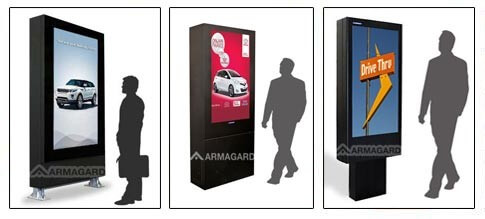
Selecting the right display size can be a stumbling block for quick service restaurants. However, to help you select screen sizes, there are three key things to bear in mind when choosing screens for your digital drive thru menu network:
As a rule of thumb, 42 - 55 inch screens are a good place to start, but you can go bigger. Going smaller could potentially impact the number of menu items you can display and readability.
If you use a consumer screen outdoors, unprotected, it's likely that any damage sustained will void the warranty. Therefore, it's recommended that you buy commercial grade screens, which are designed for outdoor use. Most screens designed for outdoor use come with a warranty, but you should always check if it covers things like weather damage, vandalism and sunlight damage.
For added peace of mind, it's worthwhile investing in environmental enclosure systems, which protect against such threats, while preserving the warranty of your screens. Equally, an enclosure will come with its own warranty.
To function as an outdoor digital menu, your screen should ideally have an HDMI port, but these are built in to most screens currently available on the market.
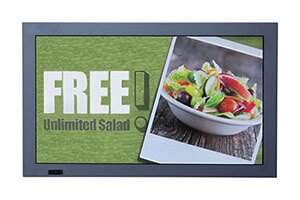
The 'thicker' the bezel on a consumer screen, the more lopsided it will look in portrait orientation.
The look of a screen is determined by the bezel. A bezel is the plastic trim that surrounds the viewing screen. The bigger the bezel, the bulkier a screen looks. Equally, if the bezel is large, less of the screen is showing. Thinner bezels are more aesthetically pleasing, but a better appearance comes at a higher price.
However, a slimmer bezel will make for a better fit in an enclosure, while making your screens more visually appealing to drive thru customers.
Commercial displays carry a higher price tag, but then they are designed for continual outdoor use for 16 hours and tend to be much more high quality than consumer screens. That doesn't mean you have to rush out and buy commercial grade screens for the sake of it, but based on experience, consumer screens carry three fundamental flaws:
1. The Bezel - The surround on consumer screens tends to be thicker at the bottom. Most digital drive thru menu boards are installed in portrait orientation, which means a screen looks uneven. Commercial grade screens have a thinner, more even bezel, which makes them better suited for menu board use.
2. Quality of Manufacturing - Commercial screens are manufactured to last longer. They can remain switched on for lengthy periods, whereas consumer screens are not specifically designed for the same sort of use. However, if you need to cut costs, consumer screens can do the job. Just be aware that they may not last as long, getting 'washed out' by direct sunlight and potentially costing you more in the long-term.
3. Functionality - Compared to commercial grade screens, consumer displays don't have some of the features needed to support software. Whether consumer or commercial, always check the screen has the features you need.
There are a couple of things you need to consider when using screens as drive thru menu boards:
1. Daylight: Did you know? Standard (consumer) screens are unreadable in sunlight. As a result, there's been a surge in the number of high-bright screens available on the market. High-bright screens, otherwise known as daylight or sunlight readable displays, maintain screen visibility in extreme sunlight.
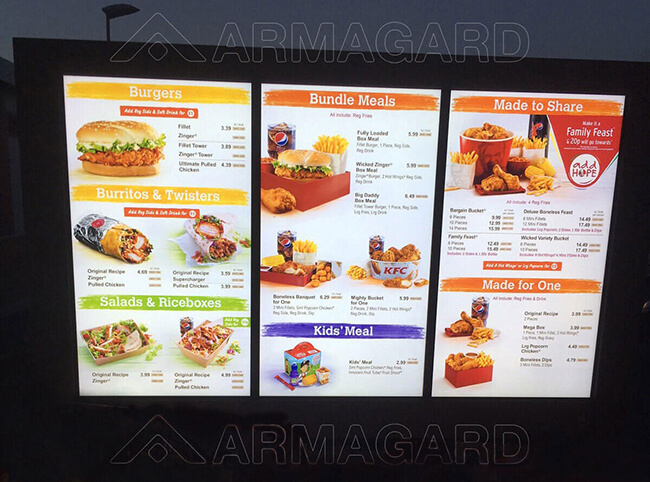
High-brightness screens are a necessary requirement for digital drive thru menu boards.
They do this by emitting a high level of light, often described as luminance, which is the measure of how much luminous intensity is coming from a certain area and how much of that light can be perceived by the human eye when looking at a screen from a particular angle. Luminance is measured in candelas per square metre, a measurement more commonly referred to as 'nits.'
What you need to know is that for a screen to be visible in extreme direct sunlight, you need a high-brightness screen with a luminance rating of at least 2,000 nits.
2. Weatherproofing: Rain, snow, condensation and temperature are major damage threats to digital drive thru menu boards. The best form of prevention is protection in the shape of an outdoor digital signage enclosure.
Enclosures are appealing because they're less expensive than dedicated outdoor screens and far more flexible, with the potential to upgrade screens independently of other hardware as technology advances. Plus, they require very little maintenance.

It's hard to hang your hat on this one as there are so many variables, such as:
The best advice is… don't overcrowd your drive thru with digital menus, but deploy enough for them to have the desired effect - boosting sales.
That concludes Part One. In Part Two... Choosing Your Software.
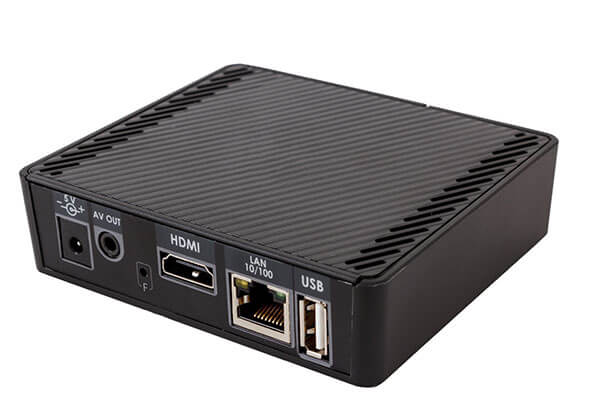
To optimise the layout of your menu on your screen(s) you will need to pair your display with the right software. Your digital drive thru menu board software will enable you to play, edit and manage your menu content from one central point.
The main thing you need to know about software is the types that are available. There are:
Don't panic, you don't need to be a tech genius to operate your digital drive thru menu board software. Downloading desktop software, for instance, is similar to downloading and opening Microsoft Excel. The software functions using your computer's hard drive.
Meanwhile, web-based applications require you to visit a software provider's site, where you can login and download software to a computer or device. Either way, the software is the main interface that you will use to select your menu content or adjust your menu design.
Previously, most menu board software was only compatible with Windows, which restricted many operators because they could only manage menus from the computer on which the software was downloaded.
However, there has been a surge in web-based software applications, mainly because it's what people want. With a web application, there's no need to install anything, you can sign into an online account and manage your menu from any computer or mobile device from anywhere in the world.
Content for your digital drive thru menu starts on your computer (either as installed software or a web application). Based on a web application, your menu is then transferred to a digital media player via the internet, which is hooked up to your screen. Using a HDMI input, the media player will display your menu directly on your screen.
A 'plug and play' digital media player is the way to go. Why? Displaying content using a desktop or laptop computer that's hooked up to your screen is not as robust.

Using web-connected media players, you're connected to your display 24/7, while updates are performed via the cloud. To get connected, your facility requires a local internet connection that's available to your digital media player, either Wi-Fi or Cellular (3G or 4G).
You can expect to pay a monthly subscription fee for software, but prices will vary depending on what features the software provides. Equally, some providers may charge for software updates. When pricing up your project, make sure you take into account monthly software fees.
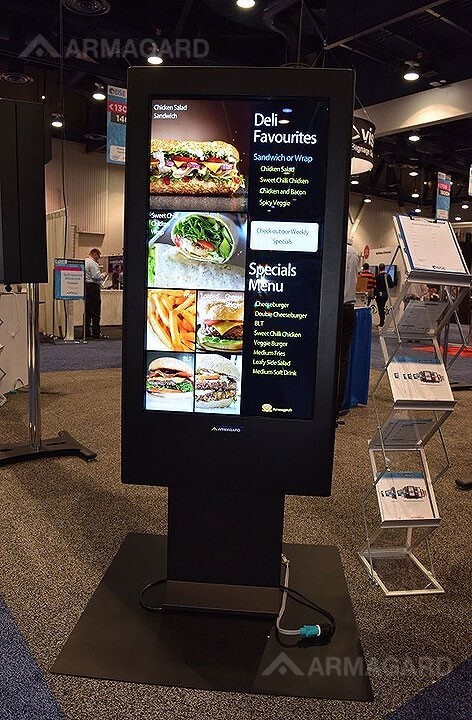
Check that the software you choose is capable of controlling menus across multiple locations. Managing your entire network of drive thru menus from one central point does provide brand consistency across all your locations and reduces the time and stress of altering each menu board individually. Plus, local stores can modify or add local offers. It's definitely worth looking into.
That concludes Part Two. In Part Three… Protecting Your Digital Drive Thru Menu Boards.
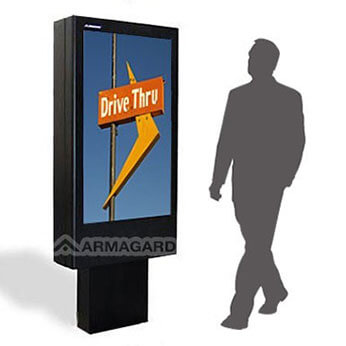
Screens, software and media players make up the core components of digital drive thru menu boards.
However, protecting these capital assets is central to the success of digital signage at the drive thru.
Much of the reasoning behind going digital at the drive thru is based on:
These factors make drive thru digital menu boards an asset worth protecting. At this point, there's a case for investing in environmental screen enclosures. Why? Because they offer the flexibility and convenience that the drive thru demands.
In contrast, dedicated outdoor screens have one fundamental flaw. Screens aren't made to last forever - even commercial grade displays! There's always that element of 'if the screen fails, everything fails…' because that will have huge ramifications for your drive thru...
...And that's the problem with screens that have integrated media players and all the 'bells and whistles'- replacing individual components can be tricky and time consuming.
As a result, users are often reliant on an engineer to come out and fix any issues, which adds to costs and prolongs downtime. It's much more ideal to be able to handle a screen issue on your own terms rather than having to depend on an engineer to repair it at your expense.
Even then, there's no guarantee that it can be fixed onsite, meaning it has to be taken offsite for repairs. Worse still, it may never come back due to permanent damage, and dedicated outdoor screens aren't cheap to replace.
With that in mind, when a menu display 'bites the dust,' you need to be able to swap it out quickly, with the minimum of fuss and with minimal downtime. Enclosures are easily accessible and durable.
A screen and media player housed in a high-quality outdoor enclosure keeps you in control, should a key piece of equipment fail. They're easily accessible and enable you to change equipment at your convenience to get your digital drive thru menu up and running again in a shorter time frame.
The upshot of enclosures is that they can prolong the life of consumer screens to the point that they will last as long, if not longer, than a screen that's built to be outside.
From a business perspective, the return on investment potential is more attractive than that of a dedicated outdoor screen. Plus, the convenience, flexibility and the upgrade options that come with having enclosures saves on the most precious commodities a business has, time and money!
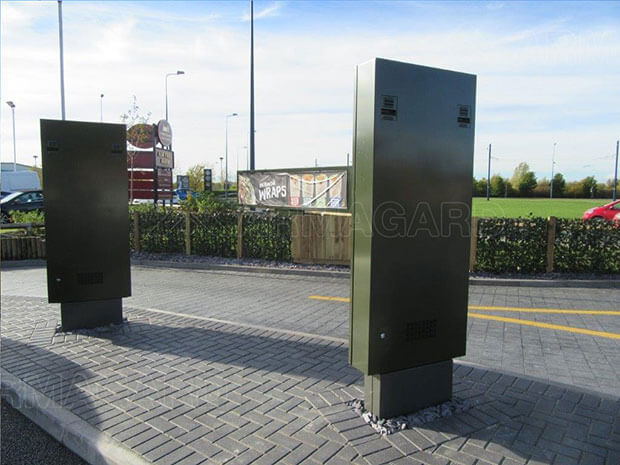
Current enclosure designs are sophisticated, stylish and more importantly, customisable, enabling you to incorporate company colours to maintain a uniform brand image, while blending in with the surroundings, which is ideal when placed in a position as prominent as a drive thru.
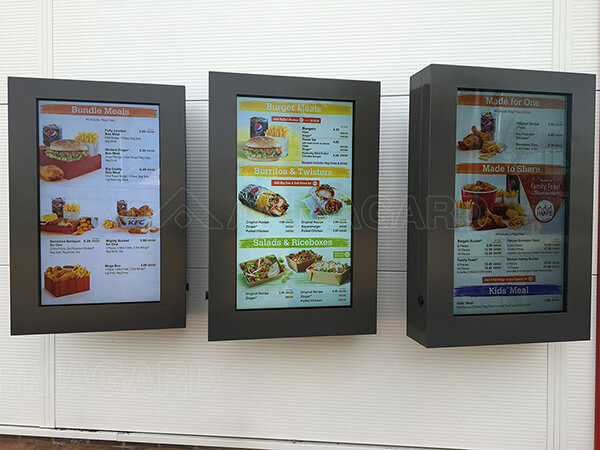
Enclosures aren't as secure... Enclosures can actually look less intrusive than a dedicated outdoor screen, making it a little less obvious that you're using a digital screen, which from a security perspective, has its benefits. For instance, if a screen is in an enclosure it makes it less likely to become a target for thieves.
In contrast, an exposed screen that hangs from a frame alone requires less effort to steal and could be tempting to opportunist thieves in the dead of night.
But integrated screens are easier to install and ready to go... Not necessarily. Enclosures can be installed just as quickly as dedicated outdoor screens, especially if you have your vendor install them and then hook up your screens and media players. You could be up and running sooner than you think.
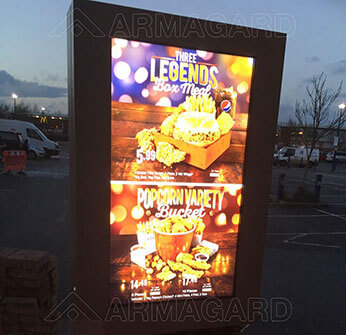
Enclosures, complete with screens and media players, can be fitted in a matter of hours. Here is an example of an Armagard 47” unit fitted for KFC.
OK... but outdoor screens are less prone to weather damage and hindrances, right? No. Enclosures offer equal, if not better protection, against the elements than their outdoor screen counterparts. Whether heat, cold or screen glare, enclosure systems are equipped to combat these factors that will affect the function of a screen, preserving - and in many cases - increasing the lifespan of displays.
To prevent overheating at the height of a summer's day, enclosure units are equipped with fans and air conditioning systems to ensure that the temperature within remains at a level in which a screen can still function. This does depend on the operating parameters of your screen - some can operate at up to 40oC, 50oC and 70 oC, while others can operate at 110 oC, without the need for air conditioning.
Equally, for sub-zero temperatures, enclosures incorporate heating units to prevent components freezing. Again, the temperature within a unit is kept at an optimum level to maintain the correct operating temperature.
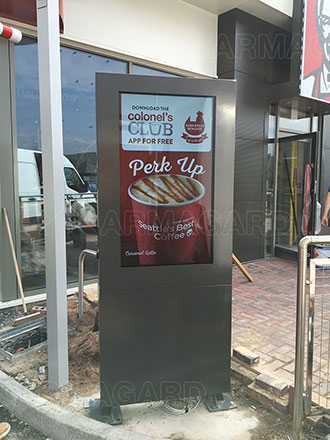
Digital drive thru menu enclosures keep screens and media players fully functioning, whatever the weather.
Dealing with glare and reflections is taken care of too. The protective viewing screens that form 'the face' of enclosures can be coated with anti-glare or anti-reflective technology, maintaining the visibility of your digital drive thru menu boards by reducing reflections from 4%, down to less than 0.4%.
Better still, enclosures can house high-bright screens, which are designed for use in daylight. A high-brightness screen combined with an enclosure featuring anti-glare or anti-reflective technology will ensure screen visibility never becomes an issue.
Putting this into perspective, you're switching from static drive thru menu boards. No doubt those menus are housed in some sort of protective surround with a polycarbonate screen. Therefore, housing digital versions of your menu in an enclosure at the drive thru can't be that far-fetched for you, it's a logical upgrade that makes sense.
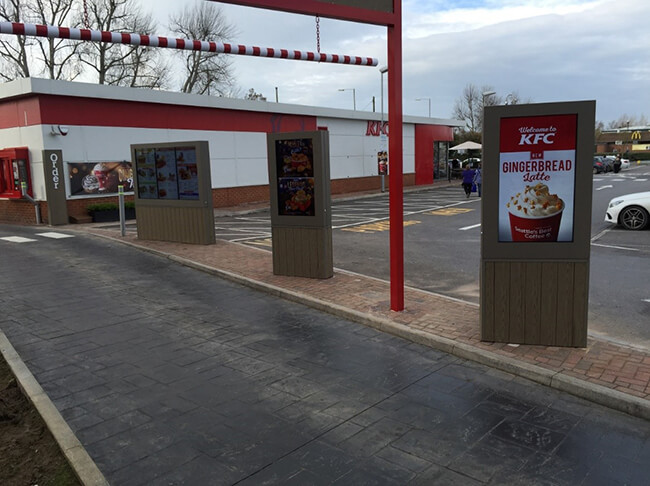
It's easy for us to 'wax lyrical' about the reasons for having enclosures for pages and pages, but let's nail the main reasons for having them right now...
1. Increasing Revenue — Enclosures enable you to take digital menus to the drive thru, which in turn delivers a potential 3 - 8% boost in fast food sales.
2. Dayparting Improvement — With digital menus positioned at the drive thru, you can switch between breakfast, lunch and dinner menus, seamlessly.
3. Flexibility — This is your biggest ally, and enclosures give you flexibility in abundance. They can house a screen of your choosing and they can be customised to blend in with your restaurant's surroundings, plus so much more.
4. Upgradability — The flexibility of enclosures means that upgrading to new screens as technology advances is made easier, upgrades do not come with a requirement to be highly tech savvy.
5. Cost-Effective — Because you can use screens and media players you have chosen, you can keep costs down. Integrated systems tend to be pricier, mainly due to the fact that you're paying for the convenience of one complete system.
6. Proven — They work, enclosures exist because there is a need and demand for them. In recent years, this has become more apparent at the drive thru. With many all-in-one systems still priced at a premium, restaurant chains appreciate the value of enclosures and the longevity they bring.
While you can source your own screens, media players, software and enclosures separately, the ideal is to find a vendor you can work with who can supply all the elements. One — because it saves time, two — because it cuts costs and three — because there aren't as many 'hands in the trough' and there will be less people to manage.
Moving on...you're now 'in the know' about the equipment needed to setup digital drive thru menu boards. To help you remember the essentials, just think MESS.
The question now is, why all the 'hubbub' about switching from static and going digital at the drive thru? Honestly, there are many incentives for you to switch to digital, not least because of the pain points you're probably experiencing at this very moment with your static menus...
According to a recent article, static signage use at the drive thru poses many problems [1]. To promote specials or change a menu item for instance, requires a complete overhaul of the menu itself just to add something new, or the need to print fresh material for every promotion.
Not only is this highly labour intensive, costs become astronomical. Right now, you've probably got a member of staff who has to change every menu at the drive thru. Let's face it, it's an utter waste of time. That time could be better spent serving customers.
The high maintenance nature of static signage results in a series of knock on effects, one we've already mentioned - cost. That's not the end of your problems though, is it? Scalability is a massive issue, especially if you have more than one restaurant facility. Creating a brand image that's consistent and cohesive can be problematic when static signage is involved.
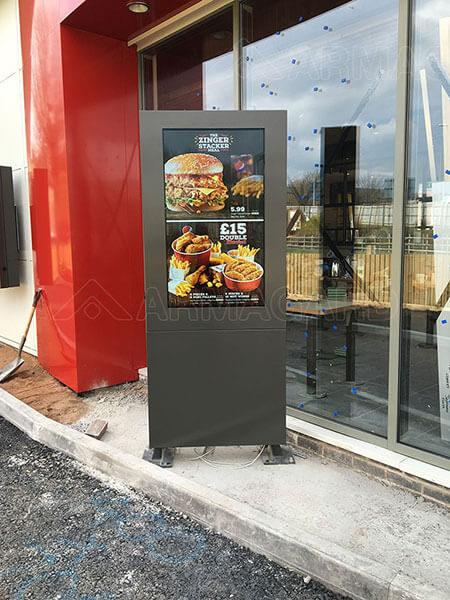
Rolling out menu changes simultaneously for instance, can prove to be a challenge. You could have one facility displaying new menu items, while another lags behind.
We don't want to give this the hard sell, but there's a reality here. Digital drive thru menus will wipe out the problems that impact static menus, in an instant. For instance, the scalability issue becomes non-existent because you can make 'global' updates from one central point that will instantly change every menu in your network at the click of a button.
Aside from making menu management much easier for you, your staff and your restaurant, the financial benefits are even more appealing. It's widely understood that going digital at the drive thru results in a sales uplift of anywhere between 3 and 8% [2]. This comes as a result of being able to make promotions more prominent and therefore, upsell more effectively.
Equally, even if you don't achieve this kind of sales boost, you will benefit by way of cutting your operational costs.
You will eliminate the need to constantly replace menus as a result of wear and tear, running promotions, adjusting menus to comply with nutritional laws and general updates. The monetary saving contributes to the overall return on investment that comes with going digital at the drive thru.
Constantly updating static menus is a continual cost - and not much fun either, but installing a digital drive thru menu network is a one-time investment with the potential to recoup your outlay in 9 -18 months according to Eclipse Digital Media [3].
Furthermore, you can upgrade to new screen technologies at a lower cost, while there's also the potential for mobile integration with menu boards to drive even more fast food sales.
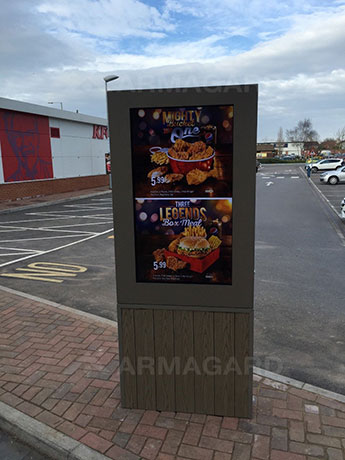
Installing digital drive thru menu boards is more than just a stylish upgrade, it's a way of improving your operational processes.
Top of the tree for incentives to go digital at the drive thru is the customer. Not only do they demand menu boards that are digital, they expect them. When all is said and done, customers are your biggest asset and your biggest critic. If you're not listening to what they think would improve their experience at your drive thru, you're not only losing that customer, but their friends and family too.
If their experience of your drive thru facility is greatly enhanced by digital menus, you can pretty much guarantee they'll be spreading the word to friends and relatives who could potentially pay you a visit.
The upshot of going digital is that it is a step forward, not only does it improve how you present your menu, it improves your drive thru and your restaurant operation as a whole - not just in the short-term. Everything from improving the customer experience, driving sales and cutting operational costs will occur as a result of switching from static to digital drive thru menu boards.
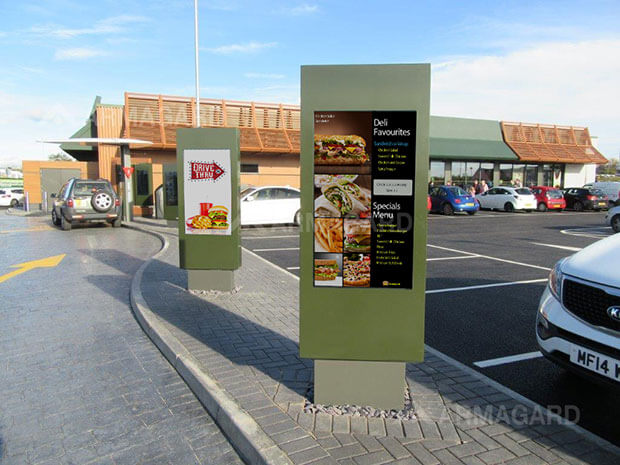
We're Armagard, and we specialise in the design and manufacture of protective enclosures for AV equipment used at the drive thru, plus computers, printers and screens used in industrial settings. We've been doing this for more than 20 years and we're responsible for protecting capital assets worth more than £5 billion worldwide.
Our experience of installing digital drive thru menu networks has been relied upon by quick service restaurant chains, and independent facilities, nationally and internationally. The latest addition to our project portfolio is one of the world's largest QSR chains. Many of the images contained in this eBook show digital menu boards in action across the UK - in a variety of weather conditions.
The project involved many custom elements, including the colour of the enclosures and the retrofit of each unit to achieve alignment with current printed menu designs. This ensured a brand match that blended in with existing site surroundings, helping to define the QSR chains's image.
This particular project demonstrates just how flexible and stylish enclosures can be, while emphasising their practical capabilities, especially the protection they provide in different weather conditions. You can also get a sense of the designs available, you will have noticed that some are freestanding, while others are mounted in a portrait orientation on a frame.
Our work with this major QSR brand not only blows any misconceptions about enclosures out of the water, but demonstrates the importance of partnering with a vendor who puts customer requirements at the centre of a project. Partnering with Armagard takes you beyond getting a 'bog-standard' solution that's only fit for the short-term.
You can expect high-quality solutions, designed to last, and gold-standard service that doesn't stop once your systems are installed. We will help you with everything you need to make the switch from static to digital drive thru menu boards, from sourcing screens to getting you up and running, Armagard can support you every step of the way.
Remove the stress, remove the pressure. Choose Armagard, a name you can rely on for your project today, tomorrow, for the long-term.